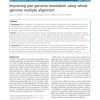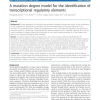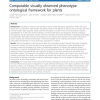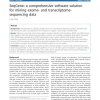150
Voted
BMCBI
2011
14 years 4 months ago
2011
Background: Comparison of the human genome with other primates offers the opportunity to detect evolutionary events that created the diverse phenotypes among the primate species. ...
131
Voted
BMCBI
2011
14 years 4 months ago
2011
Background: The substitution rates within different nucleotide contexts are subject to varying levels of bias. The most well known example of such bias is the excess of C to T (C ...
134
click to vote
BMCBI
2011
14 years 4 months ago
2011
Background: Liquid chromatography-mass spectrometry (LC-MS) utilizing the high-resolution power of an orbitrap is an important analytical technique for both metabolomics and prote...
148
click to vote
BMCBI
2011
14 years 4 months ago
2011
Background: Rapid annotation and comparisons of genomes from multiple isolates (pan-genomes) is becoming commonplace due to advances in sequencing technology. Genome annotations c...
152
click to vote
BMCBI
2011
14 years 4 months ago
2011
Background: Current approaches for identifying transcriptional regulatory elements are mainly via the combination of two properties, the evolutionary conservation and the overrepr...
144
click to vote
BMCBI
2011
14 years 4 months ago
2011
Background: The ability to search for and precisely compare similar phenotypic appearances within and across species has vast potential in plant science and genetic research. The ...
145
Voted
BMCBI
2011
14 years 4 months ago
2011
Background: The popularity of massively parallel exome and transcriptome sequencing projects demands new data mining tools with a comprehensive set of features to support a wide r...
159
Voted
BMCBI
2011
14 years 4 months ago
2011
Background: Gene set analysis (GSA) has become a successful tool to interpret gene expression profiles in terms of biological functions, molecular pathways, or genomic locations. ...
137
click to vote
BMCBI
2011
14 years 4 months ago
2011
Background: Alternative splicing of pre-mature RNA is an important process eukaryotes utilize to increase their repertoire of different protein products. Several types of differen...
146
Voted
BMCBI
2011
14 years 4 months ago
2011
Background: Genome-wide transcriptional profiling of patient blood samples offers a powerful tool to investigate underlying disease mechanisms and personalized treatment decisions...




